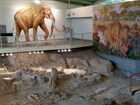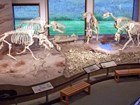The Cenozoic Era (66 million years ago [MYA] through today) is the "Age of Mammals." North America’s characteristic landscapes began to develop during the Cenozoic. Birds and mammals rose in prominence after the extinction of giant reptiles. Common Cenozoic fossils include cat-like carnivores and early horses, as well as ice age woolly mammoths.
-
Article 1: Quaternary Period—2.58 MYA to Today

Massive ice sheets advanced and retreated across North America during much of the Quaternary, carving landscapes in many parks. Bering Land Bridge National Preserve contains geologic evidence of lower sea level during glacial periods, facilitating the prehistoric peopling of the Americas. The youngest rocks in the NPS include the lava of Hawaii Volcanoes National Park and the travertine at Yellowstone National Park, which can be just a few hours old. Read more
-
Article 2: Neogene Period—23.0 to 2.58 MYA

Some of the finest Neogene fossils on the planet are found in the rocks of Agate Fossil Beds and Hagerman Fossil Beds national monuments. Read more
-
Article 3: Paleogene Period—66.0 to 23.0 MYA

Colorful Paleogene rocks are exposed in the hoodoos of Bryce Canyon National Park and the badlands of Badlands and Theodore Roosevelt national parks. Extraordinary Paleogene fossils are found in Fossil Butte and John Day Fossil Beds national monuments, among other parks. Read more
